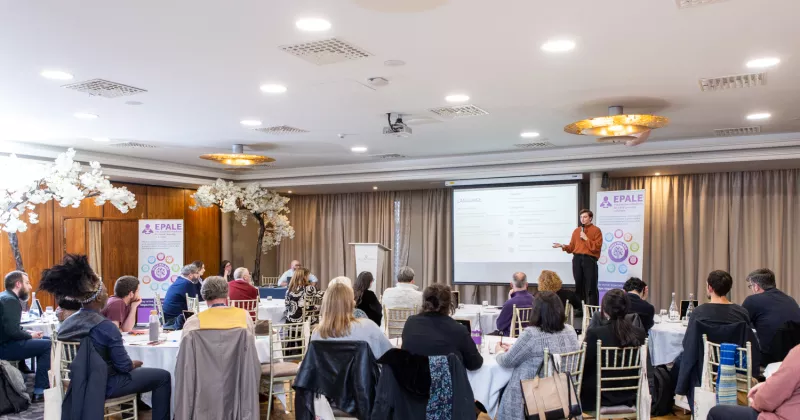When it comes to social media, one size does not fit all
Picture this - The Facebook feed reveals a line of male and female colleagues, sheepishly grinning at the camera with, perhaps, two of them sharing the task of holding a cut-out polystyrene sign which reads: "#Youth4Climate" or some-such worthy hashtag that the project partners have agreed upon as part of their publicity and dissemination efforts. Underneath is a lengthy caption that begins: "Whatever Organisation was delighted to attend the kick-off meeting of our Erasmus Plus project in...". The post has attracted a number of 'likes' and even some "loves" as well as a handful of one-line upbeat comments. Closer inspection, however, reveals that the interaction has come from project partner team members and, perhaps, a few motivated climate action activists who have wandered onto the feed. Sound familiar?
Whilst disseminating to peer organisations is, undoubtedly, one valuable facet of a campaign, a vital target is, in most cases, the project's target group. And, let's face it. They are not always your most ardent social media followers. Quite often, there is an age gap between those delivering and those receiving the training. According to 2024 statistics published by Social Sprout, Facebook is most popular among those over 40. Those in their 30s prefer Instagram. Instagram is also popular with the under 30s, but not as much as TikTok or Snapchat. So if, for example, we're relying on our organisational Facebook page to disseminate our project information to our youth target group, we're likely to be barking up the wrong tree.
So what's the answer? Do you create an account on every platform and post your picture and caption to each one? Unfortunately, it's not that straightforward. Setting up a TikTok account and posting your row of grinning meeting attendees with the accompanying message of how delighted everyone was to be standing there is doomed for a number of reasons. Firstly, the picture and caption format is completely wrong for that platform. TikTok uses short video clips or groups of pictures that the user can thumb through like a picture story. Secondly, the 'you scratch my back and I'll scratch yours' implied deal among Facebook-using organisations, to gather 'likes', doesn't apply on TikTok, because, if a post doesn't perform well with the first 300 views, the algorithm gives up pushing it out - and this misplaced post certainly won't perform well. So your quid pro quo organisations are unlikely to ever see your post in the first place. Also, and crucially, unless you're a brand like Apple or Netflix, the TikTok community, with its emphasis on real people being seen to be authentic, is unlikely to treat your organisation account with much credibility. To reach your target audience, then, requires some additional time, thought and effort - elements that most of us are already in short supply of. But putting in the effort can result in huge rewards.
In 2008 I made a 4-minute social film about homelessness, funded by the Irish Film Board. Despite qualifying for the Oscars in 2010 and winning a gratifying number of awards at festivals around the world, the film was probably seen by no more than 10,000 people. The same film, posted to my private TikTok account has been viewed over 600,000 times. Over 120,000 of those viewers took the time to 'like' the post. Indeed, over 1,100 went further and left a comment and over 11,000 bookmarked the post as a 'favourite' so that they could return to it. The social impact of that post - which took a matter of minutes - was massively greater than two years of travelling the film festival circuit and showing to cinema audiences. I repeated the experiment with another social film - a short animation on carers dealing with Alzheimer. This was viewed by 1.9 million people and 'liked' by 195,000 of those. Such staggering numbers have seen Facebook and Instagram's parent, Meta, introduce TikTok-like elements to both platforms. Even YouTube jumped in on the short mobile-phone-friendly clips.
The challenge for those of us in education, training and social development, therefore is to raise our heads above the comfort parapets of our favourite social media platform, and to start identifying what social media platforms are the stomping grounds of our target group. Then we must figure out which content they are most likely to engage with. Once we've analysed that, we can start thinking of imaginative ways to animate that line of grinning colleagues at a project kick-off meeting into something that might raise a smile, a tear or an eyebrow among our identified social media users. Maybe we'll need different versions of the same content for different platforms. Maybe we'll need to find someone charismatic to represent our organisation who presents a face and a personality rather than a logo. True, it's going to take a lot more work than popping up a picture and changing the project name on a copy-and-pasted caption. But the results can be viral and, who knows, you might have some fun along the way.
Declan Cassidy, Executive Director, EurAV European Audio Visual CLG, Ireland





